Built at a cost of £8,000,000, and a magnificent contribution to ocean-liner travel, the electrically-driven “Normandie” represents the peak of French maritime achievement
WORLD’S LARGEST SHIPS - 2
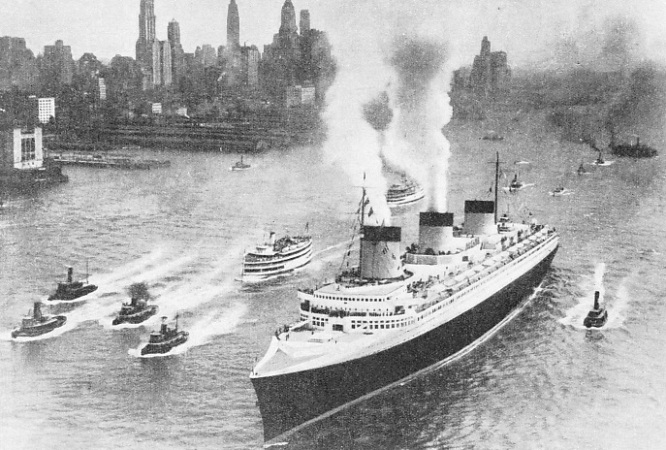
ARRIVAL AT NEW YORK of the Normandie, escorted by tugs and small steamers, at the end of her record-breaking maiden voyage, when she crossed the Atlantic in four days, three hours, two minutes, the average speed from Bishop' Rock Lighthouse to the Ambrose Light being 29·9 knots.
THE Normandie is one of the most powerful and one of the largest electric floating power plants yet constructed. She was designed and built, at a cost of approximately £8,000,000, at the Penhoet shipyard at St. Nazaire at the mouth of the River Loire, for the Havre-Southampton-New York express service of the Compagnie Generate Transatlantique, better known as the French Line. Four years elapsed between the laying of her keel and her trial trip. With ships of this class it is not easy to convey by mere figures the size of any given vessel. Such vessels are few, and they have but recently jumped far beyond the preconceived ideas of the limitations beyond which designers and engineers might go.
If, however, we can imagine the Normandie removed from her natural element and placed in Piccadilly, London, she would stave in the sides of the buildings to a distance of 18 feet on either side, her greatest beam being as much as 119 ft 5-in. Similar comparison may be made with any other street known to the reader to enable him to get some idea of her giant proportions.
The Grand Dining-Room is of proportions never before seen in a ship. An ordinary cross-Channel ship could be docked easily within this room, the ceiling of which is three decks high. The length of the room is just over 300 feet.
The overall length of the Normandie from the bow to extreme aft is 1,029 ft 4-in, the length between perpendiculars of the ship being 962 feet, with a beam at the main deck of 117 ft 9-in. The depth moulded to the promenade deck is 91 ft 10-in. When fully loaded with passengers, stores, fresh water, crew and the like, she will displace some 66,400 tons, and in this condition will draw about 36 ft 7-in of water. The gross registered tonnage is 79,283. The capacity of her fuel bunkers is 339,000 cubic feet. It was no small problem of marine engineering, therefore, to devise machinery that would drive this giant at 28 knots, equal to more than 30 land-miles, an hour. To achieve this by means of electric power was to attempt something that was unique. In brief, the power is given to four main propulsion motors by four main turbo-generators, each of 33,400 kW output, a total of 133,600 kW. There are also auxiliary generators, giving a load of 13,200 kW for lighting, pumping, heating, and so on - a total electric load of 146,800 kW, which is appreciably more than the total peak hour electric load taken by the whole of London’s underground electric railways. If all her machines were developing the same type of current at the same time, the Normandie could provide more than enough energy to run the whole of the London underground railways at their busiest moment. Current is generated exactly as in a land power-station, and is conveyed to the four 40,000 hp motors, each one of which is coupled to a propeller. The four propellers, which, when cast, weighed 37 tons each, transmit a total propulsive force of 160,000 hp, which is approximately equal to the horse-power of 100 of the most powerful locomotives used on the British railways.
Nearly 2,000 Passengers
The power plant takes its energy from twenty-nine main water-tube and four auxiliary “Scotch” boilers, the former delivering steam at 400 lb per sq in. pressure and at a temperature of 350 degrees C. These are arranged in special compartments forward of the main power room.
The hull of the ship has twelve decks - sports deck, sun deck, boat deck, promenade deck, upper deck, and decks A, B, C, D, E, F and G. Of these, five - namely, A, B, C, D and E - extend the whole length of the ship, but the two decks below these, F and G, are interrupted by the engine and boiler rooms. There is accommodation in all for 1,972 passengers, of which 28 are of grand luxe class in special suites, 30 are in luxe class, 790 in ordinary first class, 16 in intermediate class, 654 in tourist, 139 in what is known as mixed class and 315 in third class.
Officers, crew and personnel number 1,345, made up of 66 officers, 120 deck crew, 187 engine-room crew and 972 stewards, cooks, waiters and other servants. Thus the total number of persons who can be embarked in the Normandie is 3,317. The vessel has a hold and ‘tween deck cargo space of 133,300 cubic feet capacity, and has sufficient room in her double skin to take 8,930 tons of fuel oil, 6,600 tons of fresh water and 554 tons of salt water.
The hull is of peculiar shape in relation to the water-line portion and also to the superstructure. The vessel is very full amidships and fine at the ends. The above-water structure is of an inverted arch form at the stern with plentiful tumble-home, or inward rake of the ship’s side to the vertical, amidships and a very big flare forward, finishing at a stem profiled as a clipper bow. The great height of the ship and the previously mentioned flare are designed to prevent waves from breaking on the promenade deck (shaped in a turtle back) in the worst of weather. The turtle back, well cleared of all obstructions, is carried by a strong framing and has a pronounced arch. It ends at its aft part in a breakwater, shaped as a cut-water. In this way, the largest waves falling on to this part of the ship cannot remain and are thrown back without having caused any damage. This arrangement, the French engineers claim, enables the ship to proceed at full speed through the water in almost any weather.
Aft of the breakwater is the forward end of the central superstructure, including the promenade deck, boat deck and sun deck, rounded in form and specially reinforced at its lower portion to withstand the eventual impact of waves. The fore end of the promenade deck is slightly recessed at its upper part. This limits the forward end of the boat-deck and sun deck, which include forward wheel-house, chart-room, navigation equipment-room, captain’s quarters and radio-room. It is interrupted by the two forward funnels and is taken up again by the great main lounge dome. The aft part includes the engineers’ quarters and two suites de luxe.
Many of the Normandie’s characteristics are common to all recent ships built for the French Line, for the decks are absolutely stripped of ventilators, air fans, winches and other details. The ventilating system is concealed in the superstructure and is operated by means of fans; the whole of the navigating equipment - windlasses, winches and the like - is arranged underneath the turtle back. This arrangement gives a large, clear area suitable for deck sports - an increasingly important facility in modern passenger ships. Aft, the various decks end in successively receding stages, beginning with the promenade deck and finishing at A deck, the whole forming terraces where passengers of all classes can have a clear view over the sea. The main deck terrace has an open-air swimming pool for tourist-class passengers.
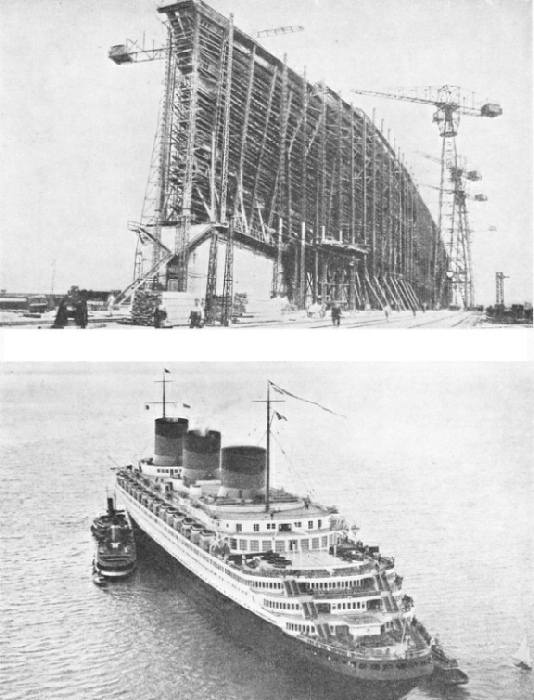 BUILDING THE GIANT HULL of the Normandie. The vessel was designed and constructed at the Penhoet shipyard at St Nazaire, at the mouth of the River Loire, for the Havre-Southampton-New York express service of the Compagnie Generate Transatlantique. The first keel plate was laid on January 24, 1931. This picture was taken on July 1, 1932, when the steel framing was practically complete and when construction of the superstructure had begun.
BUILDING THE GIANT HULL of the Normandie. The vessel was designed and constructed at the Penhoet shipyard at St Nazaire, at the mouth of the River Loire, for the Havre-Southampton-New York express service of the Compagnie Generate Transatlantique. The first keel plate was laid on January 24, 1931. This picture was taken on July 1, 1932, when the steel framing was practically complete and when construction of the superstructure had begun.
READY FOR THE HIGH SEAS. The Normandie was successfully launched on October 29, 1932. After the launch the work of fitting out and installing her machinery proceeded rapidly. The overall length of the vessel is is 1,029 ft 4-in, and the length between perpendiculars 962 ft, with a beam at the main deck of 117 ft 9-in. When fully loaded, her displacement is about 67,500 metric (66,400 English) tons. Gross tonnage is 79,283. Power is given to four main propulsion motors by four compound turbo-generators, each of 33,400 kW output.
The enormous funnels are three in number; the after one is a dummy and contains a series of dog kennels. The funnels are streamlined, their height decreasing from forward to aft, and they are slanted at 10 degrees. The two forward funnels have been specially designed to prevent any boiler-deposit from falling on to the deck. The two pole masts also are raked, but at 5 degrees only, and are placed forward and aft of the funnels.
At the time of the launch, which took place on October 29, 1932, the weight of the hull was 26,380 tons, without taking into account the weight of 1,280 tons represented by the sliding ways and the make-up for the launch. To save hull weight, extensive use has been made of high tensile steel. The stresses thrown on the upper structure are allowed for by the use of two expansion joints arranged at the aft part of the ship between the boiler hatchways. These expansion joints are a common feature of large vessels. The double bottom of the ship, which extends all fore and aft and up the sides, has been built on the longitudinal system. It embodies four continuous watertight girders, between which are fixed intercostal girders, the floor plates being continuous between each watertight girder.
Fire Precautions
Considerable use has been made of electric welding, mainly in assembling the following parts: the seating of the auxiliary machinery, pillars, lift shafts, bulkheads of sanitary compartments, stairways, water tanks, stiffeners and coamings. In spite of this, the total number of rivets used in the hull is well over eleven millions.
The most minute care has been taken for the safety of the ship against the ingress of water and also against fire. The double bottom, for example, which forms the water ballast tanks, is divided into no fewer than forty sections. The double hull, extending over the entire length of the engine and boiler rooms, is divided into eighty-two sections. In addition, the hull is subdivided by eleven thwartship bulkheads extending up to C deck. These bulkheads have thirty-two hydraulically operated water-tight doors and twenty-nine hand-operated doors. This great ship contains numerous other marvels, and two of these must be detailed.
With such large passenger quarters the fire risk is of more than ordinary importance. The superstructure above the main deck has been divided into sections by fireproof bulkheads and doors. Each sub-section can be completely cut off from the others, and each has its own separate safety arrangement, lighting and pumping systems, and so forth. The 448 first-class cabins have either a bathroom, shower and toilet, or just the toilet. Outside cabins have each two port-holes of an entirely new design, hinging outwards to permit of escape to the boats or sea from the cabin in the event of emergency. The rooms have standard full-sized beds, a full-length wardrobe and ample chests of drawers, full-length mirrors, special hot or cold ventilation, an armchair and a telephone. All the wood panelling is asbestos-lined, and all the furniture is fireproof. Folding beds are fitted in many of the cabins, so that in day-time the cabin can be converted into a sitting-room for entertaining, friends. These convertible rooms are, in general, constructed between two larger standard-type cabins, with which they are inter-communicating, and thus a converted room may serve one or both standard bedrooms. This plan makes it a simple matter to convert instantly a small suite for two, three or five passengers.
In the Normandie there are only 126 inside cabins. There are twenty-four special cabins, each with a private veranda, 16 feet by 12 feet. Each, too, has its own special scheme of decoration. For those who prefer and can afford the more luxurious forms of travel there are ten suites de luxe and four suites de grand luxe, with dining-room and sitting-room. Two of these suites, named respectively Trouville and Deauville, are arranged on the sun deck and have a complete open private deck 45 feet by
16 feet, with an uninterrupted view over the stern of the ship.
The public rooms in the Normandie are so large that the visitor who sees them for the first time is apt to become confused, not only by their lay-out, but also by the lavishness of their decoration schemes.
The general theme is the portrayal of the history of Normandy since the days of the Conqueror down to modern times. The schemes embody much that is new in the art of decoration, and have used material which hitherto has not been used in ships to any great extent.
Unique Decorations
The Grand Dining Saloon is panelled entirely with moulded glass tiles, with vertical sections of hand-hammered glass illuminated from behind. The lighting is achieved by the use of thirty-eight luminous glass standards fixed to the glass walls and by twelve large moulded glass devices fixed to the floor. These resemble fountains of light illuminating the ceiling. For this room there are eight large bronze doors opening into as many smaller diningrooms. This Grand Dining-Room has no outlook on to the sea, and is air-conditioned by special plant arranged down aft between the two inner screws.
Another feature of the Normandie is the permanent theatre-cinema. The stage of this theatre is larger than many theatre stages in London.
The main lounge is panelled entirely by etched and painted glass plates depicting the story of navigation. There are also two bronze-framed windows two decks high. An enormous smoke-room on the same deck as the main lounge can be joined to it by opening great sliding doors. This room has windows two decks high.
On the boat deck aft is a grill-room, with large windows giving on to the raised open terrace deck. This terrace, overlooking the stern and sheltered by the ship’s superstructure, gives an excellent sea view. It is furnished with long garden benches, the backs of which have heavy plate-glass screen shelters. It is floodlighted at night with large lamps. At the forward end of the promenade deck there is a complete country garden, with pergolas, shrubs, flower borders and singing birds. There are also fountains and an
aquarium. Decoration has here been so thorough that the garden is separated from the public rooms farther aft by a marble wall covered by climbing plants and bordered with fine turf. There are also a large swimming pool, a gymnasium and a complete massage and Turkish bath room. A large children’s playroom is arranged at the base of the first funnel on the sun deck. An enormous main hall in Algerian onyx, with a monumental doorway in gilt bronze, leads to the Grand Dining-Room. The fore end of this hall extends over three decks, and from it electric lifts serve the many decks. Above the main hall is an upper hall.
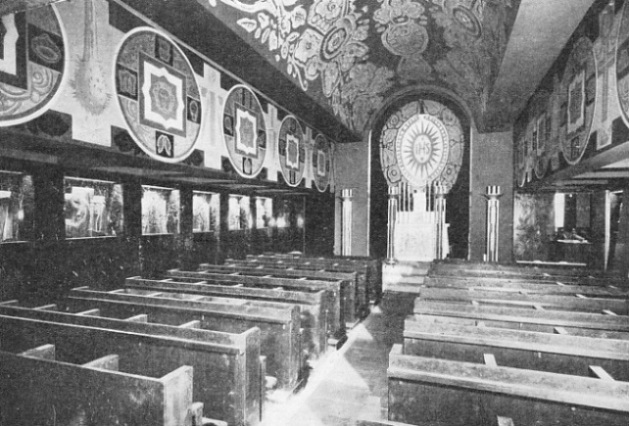
THE CHAPEL in the Normandie is situated on “B” deck, with its nave extending two decks high. The chapel has been designed for Roman Catholic and Protestant services. The arched ceiling has been specially painted and the friezes are decorated with religious symbols. Below the friezes the walls are of Pyrenean marble relieved by fourteen panels illustrating scriptural subjects. The floor of the chapel is covered in rubber tiling.
The tourist-class passengers have accommodation extending over three decks, with a complete set of public rooms, including a gymnasium and children’s playroom. The tourist-class has also the open-air swimming pool to which reference has already been made. The tourist and third-class quarters also have each an electric lift. The whole of the accommodation for third-class passengers is situated aft instead of forward, as in so many other mammoth liners. There is a large sheltered sun-deck for “thirds”. The crew’s quarters in this ship are fitted out to a high standard and are reminiscent of the second-class in older ships. All beds in the ship, including the crew’s dormitories, have spring mattresses.
In choosing propelling machinery for a ship of this size the architect has had the choice of geared turbines - that is to say, turbines coupled to their propeller-shafts by means of mechanical gearing, or of turbines driving through electric generators and motors. There are protagonists and antagonists of either side. But, so far as the French Line is concerned, it was felt that, although propulsion by geared turbines had made enormous progress in the last decade, experience gained in some modern steamships has tended to show that the reduction gears inseparable from this form of propulsion in high powers especially are a source of noise and vibration. Geared turbines, while lighter and less bulky than turbo-electric drive, have an advantage which can be set off only if very high-pressure, light-weight boilers are selected. Other technical reasons influenced the choice, but in general the owners of the Normandie decided that electricity was the more flexible power and that the total plant could be distributed over the bottom of the ship with greater consideration for the passengers than would be likely with geared turbines.
The power plant for main and auxiliary purposes is broadly divisible into three portions: the boiler-room, the main power-room and the motor-room. This last contains also the distribution panel and high-tension switch gear, as well as the refrigerating machinery and plant for conditioning the air in the dining saloons. The main boiler-rooms contain twenty-nine water tube boilers. The main power-room is a magnificent two-decked space some thirty-six frame spaces in length. It is “two-decked” in the sense that condensers, enormous circulating pumps and other auxiliary gear are arranged directly under the turbines which they serve. Alternating current at 5,000 volts is generated in four compound turbo-generators. These are arranged at the aft end of the power-room, while above and abaft them is the main control panel for propulsion. This, so far as the space occupied by the switchboards is concerned, is a comparatively simple affair. It is only when the back regions of the board are studied that it is possible to realize the enormous problems involved in the design and arrangement of propulsion equipment of electric type for a ship of this size.
Record Trip
Facing the main control boards are two small boxes resembling in shape a covered-in musical organ. Two short levers moving in a fore-and-aft direction in each box are all that is required for manoeuvring each pair of 40,000 shp, 30,100 kW three-phase synchronized propulsion motors.
The main switchboard for direct current auxiliary purposes is at the forward or boiler-room end of the main power-room, and this occupies practically the whole width of the ship between the inner bottom shell. This main board distributes the current from six dc machines, each driven by a turbine through gearing, the turbines turning at 2,500 rpm while the generators turn at 530. These supply current at 225 volts and are of 2,200 kW output each.
Some idea of the auxiliary requirements of the ship may be realized when it is stated that the two refrigerating machines take 77½ kW each and the twenty special forced-draught fans take 57·5 kW each and turn at 620 rpm. For the hotel load there are no fewer than forty-four cables, and thirty-six cables for the auxiliary machinery. The steering gear itself, which is of electric-hydraulic type, has three motors of 48 kW each. There is also an extensive emergency stand-by system on the promenade deck itself. The entire propulsion machinery is contained in six watertight sections, four of which are devoted to the steam-producing plant, that is, to the boilers, the two others being allotted to the propelling and electrical plant. The maximum output in continuous service is
160,000 hp, equally divided between four shafts.
The Normandie entered service on May 29, 1935, when she left Havre for New York, via Southampton, on her maiden trip. Those who were privileged to be present on board during the cross-Channel part of the voyage will not forget the enthusiastic scenes which marked the departure of the ship from her home port. She made a record passage to New York and returned successfully. Many important technical advances were made in the science of electric propulsion as a result of this first passage. Some figures are available which indicate the excellent performance which this huge liner put up on her maiden trip. It should be remembered in this connexion that no passenger liner is ever run full out on her first voyage or voyages.
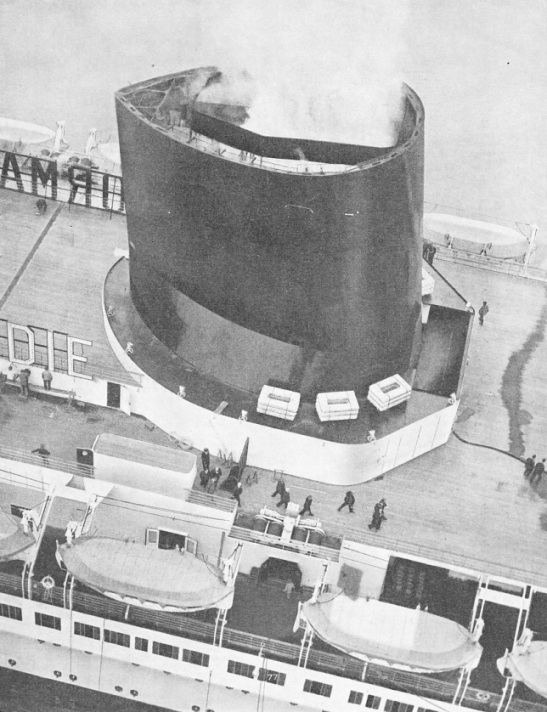
AN UNUSUAL ANGLE of the Normandie’s deck was obtained by the photographer of this illustration. The funnels are streamlined, their height decreasing from forward to aft, and they are raked at 10 degrees. The picture shows also some of the ship’s life-boats, the largest of which are 42 ft 10-in by 11 ft by 4 ft 11-in, and are propeller-driven. The total capacity of all boats is 3,582 persons, or 8 per cent in excess of the capacity of the ship.
The Normandie, however, running westbound to New York from Southampton, made a mean speed of 29·53 knots at easy steaming. Her best day’s run from noon to noon was as much as 754 miles, the average over this twenty-four-hours period being 29·92 knots. The highest speed recorded on this run was 31·37 knots, equivalent to a speed of about thirty-five land miles an hour. When we take into consideration the enormous bulk of this ship we get some idea of the great power and energy required to push her through the water at this speed.
Eastbound on her maiden trip the mean speed for the voyage was slightly better - 30·34 knots. The best day’s run, however, was rather less, being 707 miles, while the highest recorded speed was 30·91 knots. Taking mean figures for the first six trips, we find that the total mileage run by the ship amounted to 38,753 nautical miles at a mean speed of 28·55 knots, the consumption of fuel oil for all purposes working out at 1,492 kilogrammes (3,289 lb) per mile run.
These prosaic figures clearly show what the modern transatlantic mammoth is capable of doing. They also give an idea of the tremendous responsibility of the engineers. For a power plant such as that of the Normandie, it is evident that there must be many points which have to be watched continuously. Furthermore, in a novel type of power plant such as this many difficulties may occur which could not have been anticipated when the design of the ship was on the drawing-board. For instance, on the first east-bound voyage it was found that when the ship got into shallow water near the Ambrose Channel, the motors on all four shafts suddenly cut out.
This at first was inexplicable and every regulation test was tried to discover what had happened to the power plant. The tests confirmed that the ship was operating correctly and that no breakdown had taken place. It was finally found that, when the ship ran into shallow or shoal water near the American coast, the load on the motors differed from the normal load at full running power with the turbine valves fixed at their correct speed for that power. This difference in load without corresponding adjustment on the control levers at the desk in the engine room naturally altered the working of the governors and hence tended to cut
current out on the whole system. Another of the many advantages of electric propulsion for large ships is thus proved. It shows that when the vessel is approaching at full speed in shallowing water, perhaps unexpectedly, there is immediate and drastic warning of this - the power plant shuts down. Had the trouble not been traced to its real source, it is probable that this additional advantage might never have been discovered.
Pioneering Experience
A further example from the Normandie’s maiden voyage shows how much is learnt on such occasions. Some trouble was experienced with the condenser tubes in one of the four main condensers of the big compound turbo-alternators on the voyage. This made it necessary to cut out that particular alternator while repairs to the tubes were effected.
Difficulties with condenser tubes are quite common and reflect neither on the type of tubes nor on the builders. What was interesting in the instance of the Normandie, and equally true of any electric ship, was that all four screws could still be kept running and produce power with one of the main turbo-alternators cut out for repairs to the condenser. Had the ship been a geared turbine vessel it would have been necessary to cut out not only the turbine concerned, but also the whole of the propulsive system, including the shafting and the propeller. The vessel would then have had to proceed on three out of four screws, with compensating helm to equalize the drive of two screws on one side and one on the other. This statement is not put forward in any spirit of criticism of direct-geared turbine drive, but it is advanced to show that electricity does give a flexibility not possessed by other types of propulsion.
Finally, in assessing the characteristics of the ship it must be remembered that many of them had no precedent. When the Normandie was designed a clean drawing-board was commanded and to a great extent a dip into the future was made in. constructing this high-speed streamlined ship.
Many people think that she is in appearance the first of the high-speed, streamlined ships that will eventually plough the Atlantic and other oceans at speeds hitherto considered beyond the bounds of possibility.
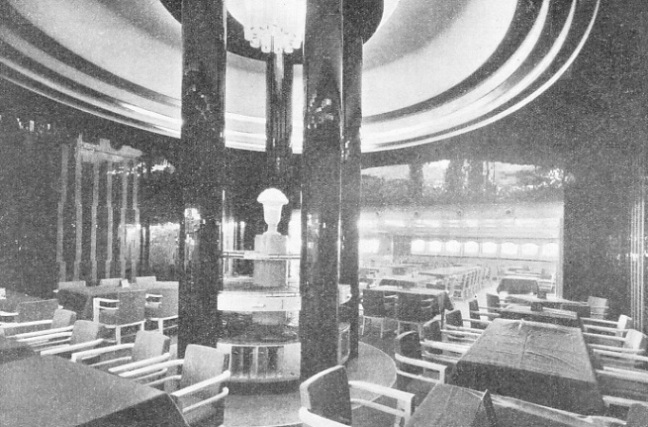
MODERN DESIGNING is a characteristic of the tourist-class dining saloon, on “C” deck, that seats 300 passengers. This capacity can be increased to 360 if necessary. The apartment, occupying the entire width of the deck, is about 103 feet wide by 66 feet maximum length, and has a central dome extending as far as “A” deck. Five great glass columns supporting an illuminated dome are striking features in the decoration of the saloon. The sides have ash panelling, and lighting arrangements have been carried out in the latest style.
You can read more on “The Chella”, “The French Navy” and “French Shipping” on this website.
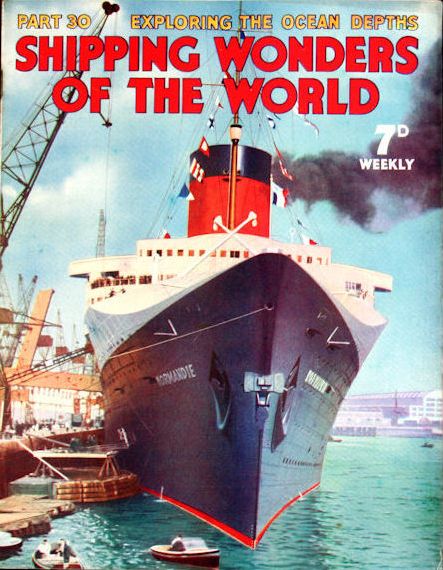
The Normandie also featured on the cover of Part 30 of Shipping Wonders of the World.
The cover illustration was later reproduced as the colour plate in part 53.




 BUILDING THE GIANT HULL of the Normandie. The vessel was designed and constructed at the Penhoet shipyard at St Nazaire, at the mouth of the River Loire, for the Havre-
BUILDING THE GIANT HULL of the Normandie. The vessel was designed and constructed at the Penhoet shipyard at St Nazaire, at the mouth of the River Loire, for the Havre-


